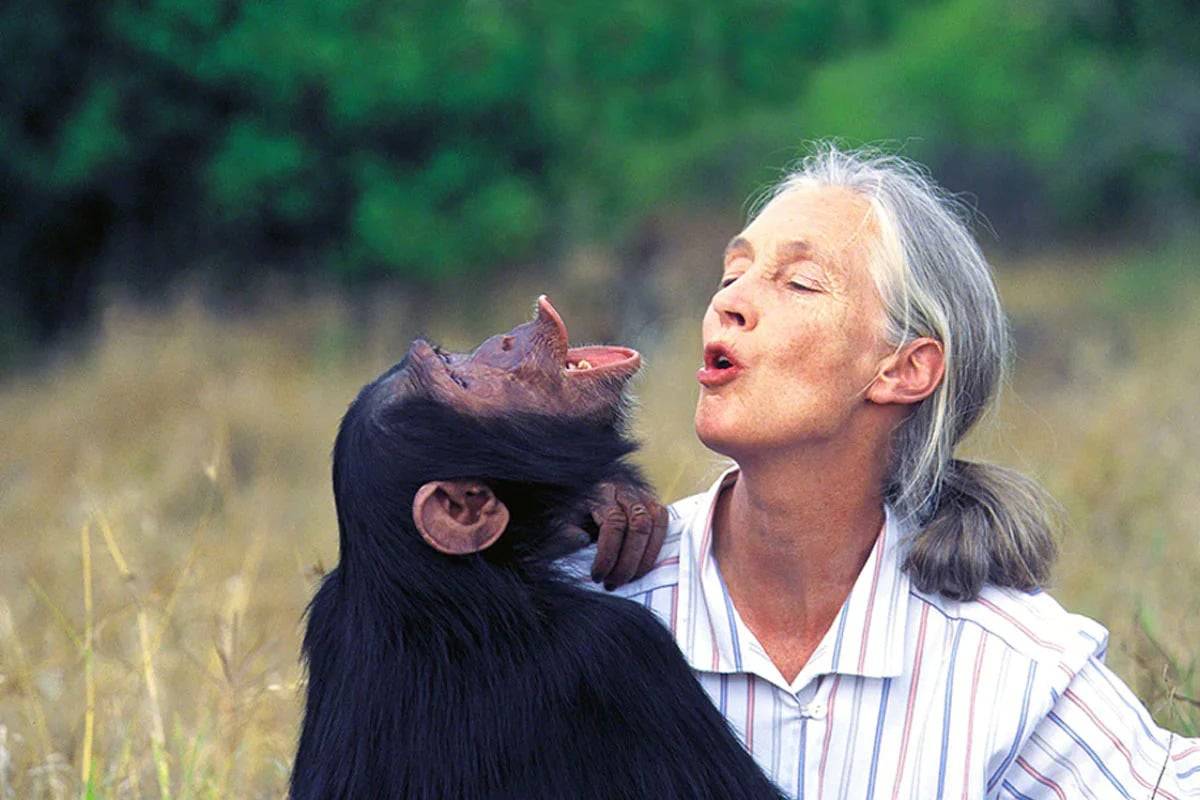
Jane Goodall, born on April 3, 1934, in London, England, is a pioneering figure in the field of primatology and wildlife conservation. From her early encounters with animals to the establishment of the Jane Goodall Institute, her journey has been marked by groundbreaking discoveries and tireless advocacy. Armed with a Ph.D. in ethology from the University of Cambridge, Goodall embarked on a transformative study of wild chimpanzees in Gombe, Tanzania, a venture that would become one of the longest continuous field studies in the history of wildlife research. This introduction delves into 25 historical facts and numerical trivia, unraveling the remarkable life and contributions of Jane Goodall.
Birth Date and Place:
Jane Goodall, a pioneer in primatology, was born on April 3, 1934, in London, England. Raised during a time when opportunities for women in science were limited, Goodall defied societal norms to make significant contributions to the understanding of animal behavior, particularly that of chimpanzees.
First Encounter with Animals:
Goodall’s early fascination with animals began at the tender age of one when she received a toy chimpanzee named Jubilee. Little did anyone know that this simple childhood gift would ignite a lifelong passion for understanding and protecting our closest relatives in the animal kingdom.
Educational Background:
Jane Goodall pursued her academic journey with dedication and perseverance. She attended Newnham College, Cambridge, where she laid the foundation for her future endeavors in ethology. Her decision to pursue a Ph.D. in ethology at the University of Cambridge solidified her commitment to the scientific study of animal behavior.
Arrival in Gombe:
In 1960, Jane Goodall embarked on a groundbreaking journey to Gombe, Tanzania, with the aim of studying wild chimpanzees. This decision marked the beginning of one of the most profound and enduring field studies in the history of primatology, as Goodall sought to unravel the mysteries of chimpanzee social structures and behaviors.
Observation Period:
Initially planning to spend six months in Gombe, Goodall’s observational period expanded into an extraordinary lifelong commitment. Her extended study, now spanning over six decades, stands as a testament to her dedication and the wealth of knowledge she has accumulated about the complex lives of wild chimpanzees.
Discovery of Tool Use:
In 1960, Jane Goodall made a groundbreaking observation that reshaped our understanding of non-human animals. She witnessed chimpanzees using tools, a behavior previously thought to be exclusive to humans. This discovery challenged the prevailing scientific beliefs of the time and opened new avenues for exploring the cognitive abilities of our closest relatives.
Chimpanzee Naming Convention:
Departing from the conventional scientific practice of assigning numbers to subjects, Jane Goodall introduced a personal touch to her study by giving names to the chimpanzees. This unconventional approach fostered a deeper connection between researchers and individual chimpanzees, emphasizing their unique personalities and contributions to the study.
Longest Continuous Study of Wild Chimpanzees:
Jane Goodall’s research in Gombe stands as the longest continuous wildlife study in history. Over the decades, her meticulous observations have provided unparalleled insights into the social dynamics, communication, and behaviors of wild chimpanzees, shaping our understanding of these fascinating creatures.
Mother-Son Bond:
Among the many significant observations made by Goodall, the documentation of a strong mother-son bond between Flo and her offspring was particularly poignant. This insight into the emotional lives of chimpanzees added a new dimension to our understanding of primate social structures and relationships.
Publication of Research:
In 1963, Goodall’s groundbreaking research findings were published in the prestigious journal “Nature.” This publication not only established her as a prominent figure in the field of primatology but also brought global attention to the remarkable behaviors exhibited by chimpanzees, challenging prevailing notions about the uniqueness of certain cognitive abilities.
First Scientific Conference:
Jane Goodall’s pivotal role in advancing primatology was solidified when she attended the first international conference on primates in 1967. Her presentation of research findings garnered widespread recognition, marking a significant milestone in the acceptance of her work within the scientific community and laying the groundwork for future collaborations and discussions in the field.
Establishment of the Jane Goodall Institute:
In 1977, Jane Goodall took her commitment to conservation and education to the next level by founding the Jane Goodall Institute. This non-profit organization became a driving force behind research initiatives, wildlife preservation efforts, and community development projects, aiming to create a harmonious balance between humans, animals, and the environment.
National Geographic Coverage:
Jane Goodall’s work reached a global audience through extensive coverage in National Geographic magazine. The vivid storytelling and captivating images not only conveyed the scientific significance of her research but also fostered public interest and support for primate conservation and the protection of natural habitats.
UN Messenger of Peace:
In 2002, Jane Goodall was honored with the title of UN Messenger of Peace. This appointment recognized her tireless efforts in promoting peace, environmental stewardship, and animal welfare on a global scale. As a Messenger of Peace, Goodall used her influential platform to advocate for the interconnectedness of all living beings and the urgent need for sustainable practices.
Roots & Shoots Program:
In 1991, Jane Goodall initiated the Roots & Shoots program, a youth-led environmental and humanitarian initiative. The program, active in over 50 countries, empowers young people to become active contributors to positive change by addressing environmental, social, and animal welfare issues in their communities.
Honorary Damehood:
Jane Goodall’s outstanding contributions to science and conservation were acknowledged in 2004 when she was awarded an honorary Damehood by Queen Elizabeth II. This prestigious honor recognized her as a dame commander of the Order of the British Empire, celebrating her exceptional service to the scientific community and dedication to making the world a better place.
Number of Chimpanzees Studied:
Throughout her extensive research in Gombe, Jane Goodall and her team have observed and documented the lives of hundreds of individual chimpanzees. This comprehensive cataloging of chimpanzee behaviors, relationships, and life cycles has provided invaluable data for understanding the complexities of chimpanzee societies.
Gombe Stream Research Center:
The Gombe Stream Research Center, established by Goodall in 1965, continues to be a hub for primate research and biodiversity studies. This center has played a pivotal role in training future generations of primatologists and conservationists, ensuring the longevity of Goodall’s legacy.
Film Appearances:
Jane Goodall’s life and work have been featured in numerous documentaries, with the award-winning “Jane” (2017) standing out. These films not only showcase her scientific achievements but also capture the personal journey of a remarkable woman who broke barriers in the male-dominated field of primatology.
Number of Books:
Jane Goodall’s literary contributions are as extensive as her scientific ones. From her early works like “In the Shadow of Man” to her later reflections in “Reason for Hope,” she has authored and co-authored numerous books that not only delve into the intricacies of primate behavior but also convey her passion for conservation and hope for a better future. Each publication serves as a testament to her ability to bridge the gap between scientific research and public awareness.
Number of Countries Visited:
Jane Goodall’s global impact is reflected in her extensive travels to over 60 countries. Her international outreach has been instrumental in raising awareness about conservation issues, advocating for animal welfare, and inspiring people worldwide to actively participate in the protection of our planet’s biodiversity.
Chimpanzee Lifespan:
Through her long-term study of wild chimpanzees in Gombe, Goodall has contributed valuable insights into the lifespan of these primates. On average, wild chimpanzees live to be around 40 to 45 years old, a critical data point that informs our understanding of their life cycles and the various challenges they face in their natural habitats.
Height:
Jane Goodall stands at approximately 5 feet 5 inches (165 cm) tall. While her physical stature is a minor detail in her extensive contributions to science and conservation, it humanizes her and emphasizes the impact that an individual, regardless of their physical presence, can have on shaping our understanding of the natural world.
Awards:
The numerous awards bestowed upon Jane Goodall underscore the recognition and appreciation she has received for her exceptional contributions. These honors include the Kyoto Prize, Tyler Prize for Environmental Achievement, and the Benjamin Franklin Medal in Life Science, among others, highlighting her impact on both the scientific and humanitarian fronts.
Current Involvement:
As of the latest available information, Jane Goodall continues to actively engage in environmental advocacy and conservation efforts. Her unwavering commitment to the well-being of animals and the planet serves as an enduring inspiration for current and future generations. Whether through public speaking engagements, educational initiatives, or collaborative projects, Goodall remains a force for positive change in the world.
People also ask:
What is Jane Goodall most famous for?
Jane Goodall is most famous for her groundbreaking research on chimpanzees in Gombe Stream National Park, Tanzania. Her pioneering work revolutionized our understanding of chimpanzee behavior and challenged the traditional view of human-animal relations.
What happened to Jane Goodall?
Jane Goodall is still alive and active as of February 2024. At the age of 90, she continues to advocate for chimpanzee conservation, environmental protection, and animal welfare. She travels extensively, giving talks and raising awareness about these crucial issues.
What did Jane Goodall discover?
Through her long-term research, Jane Goodall made several key discoveries about chimpanzees, including:
- They are intelligent and social creatures with complex social structures, using tools, forming bonds, and displaying emotions like grief and empathy.
- They are omnivores, not just vegetarians, and they engage in hunting and meat-eating.
- They share 98% of their DNA with humans, highlighting the close evolutionary relationship between our two species.
What is the story of Jane Goodall about?
The story of Jane Goodall is one of determination, passion, and scientific curiosity. A young woman with a dream of studying animals in Africa, she faced challenges and criticism but ultimately made a profound impact on the world through her dedication to understanding chimpanzees and becoming a leading voice for wildlife conservation.







